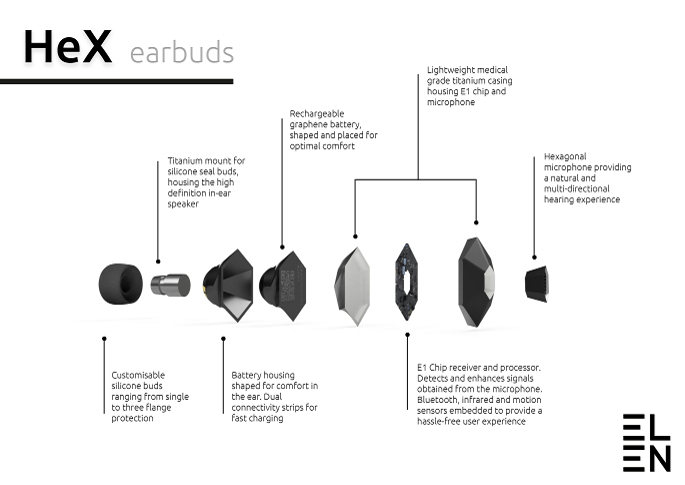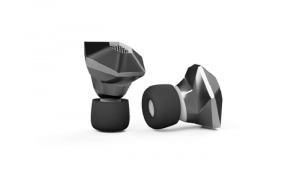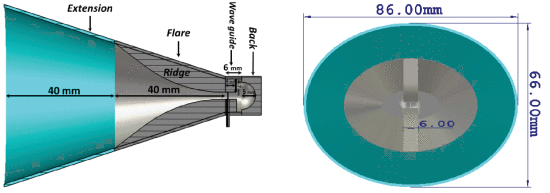
Manchester Metropolitan University graduate Elen Parry, a current Industrial Digitalisation masters student at the university and an International Autodesk Student Ambassador for the UK, is focused on using “Human-Centred Design methods” to reduce exclusion against people. Her current project is a 3D printed wireless earbud concept, aimed at helping people with hearing disabilities fight the stigma around traditional hearing aids, while enhancing their hearing at the same time.
Parry’s HeX earbuds, which were chosen by the Design Council’s CEO Sarah Weir as the top pick for this year’s ‘New Designers’ event, are audio headphones that can also be used as an advanced hearing device. The concept calls for the use of an advanced chip, which would receive and process sound signals and be able to differentiate and control what you actually want to hear and normal background noise. Users could decrease or increase the volume of their environment, which could help extend their ability to hear while at the same time protecting them against hearing loss.
 Thanks to technology like 3D printing and connected manufacturing systems, it’s now possible to produce devices like hearing aids and earbuds, and combined products like HeX, on a large scale.
Thanks to technology like 3D printing and connected manufacturing systems, it’s now possible to produce devices like hearing aids and earbuds, and combined products like HeX, on a large scale.
“My mission is to encourage social inclusion through my designs, to create improved situations for everyone. The driving principle behind creating HeX earbuds was to create a hearing device that is for everyone – whether you live with hearing loss or perfect hearing,” said Parry.
“People with disabilities often feel excluded and conspicuous because of their medical devices, so I want to transform hearing aids into a desirable wearable tech product that gives people enhanced hearing, style and confidence – something that anyone might want to wear.
“3D printing enables us to manufacture them quickly and relatively simply, so HeX earbuds could be easily produced for a mass audience.”

The HeX earbuds would be made out of silicone, with single to three flange protection and medical-grade titanium casing, and able to be personalized and 3D printed to exactly fit any ear size or shape. The product’s hexagonal shape offers a more natural, multi-directional hearing experience, which would make it possible for users to hear and process a multitude of different sounds. The idea is for the hearing aid earbuds to also provide the latest connective technologies, so that no matter a person’s hearing ability or lack thereof, HeX is still a sought after product in the mass market.
“It was my intention to design an accessible hearing aid that removes social barriers and can enhance human ability, making it desirable to a wider range of people,” Parry wrote on her site.
 For instance, HeX users could connect with other devices in order to easily complete tasks like streaming music or answering the phone while out and about through the use of embedded Bluetooth, infrared, and motion technologies.
For instance, HeX users could connect with other devices in order to easily complete tasks like streaming music or answering the phone while out and about through the use of embedded Bluetooth, infrared, and motion technologies.
Additional technologies Parry hopes to incorporate into HeX include rechargeable graphene batteries, along with dual connectivity strips for fast charging.
A 3D printed prototype of Parry’s HeX earbud concept has already been produced at the university’s advanced 3D printing and digital manufacturing hub Print City, which is open to both industry and researchers.
“This is one of many examples of how additive manufacturing and out-of-the box thinking by Elen disrupts the current design of medical devices,” said Professor Craig Banks, the academic lead of Print City.
Few industries have been affected quite as much by 3D printing as the hearing aid manufacturing industry, which switched entirely to 3D printing several years ago after Phonak, owned by Sonova, began using the technology to produce its hearing aids. The global company was seeing such success with 3D printing that the rest of the industry noticed, and quickly followed suit. Not long after, other production methods in the hearing aid world were basically wiped out by 3D printing.
With innovative products like the HeX earbuds, and makers like Parry who are conscious of and fight back against the social issues of the day, we’re truly seeing what 3D printing is capable of helping us create. I bet we haven’t even cracked the surface yet.
[Source: Design Products & Applications / Images: Elen Parry]
What do you think? Discuss this news and other 3D printing topics at 3DPrintBoard.com or share your thoughts in the Facebook comments below.










